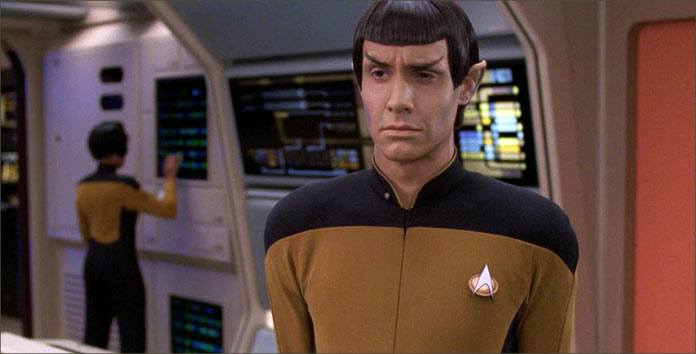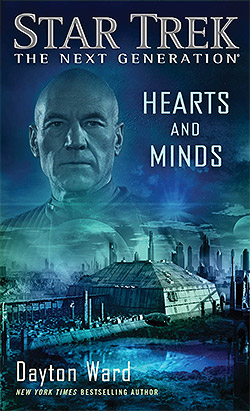2031: United States Air Force fighter jets shoot down an unidentified spacecraft and take its crew into custody.
Soon, it’s learned that the ship is one of several dispatched across space by an alien species, the Eizand, to search for a new home before their own world becomes uninhabitable.
Fearing extraterrestrial invasion, government and military agencies which for more than eighty years have operated in secret swing into action, charged with protecting humanity no matter the cost…
2386: Continuing their exploration of the Odyssean Pass, Captain Jean-Luc Picard and the crew of the Starship Enterprise discover what they at first believe is a previously uncharted world, with a civilization still recovering from the effects of global nuclear war.
An astonishing priority message from Starfleet Command warns that there’s more to this planet than meets the eye, and Picard soon realizes that the mysteries of this world may well weave through centuries of undisclosed human history…
Failed television shows rarely, if ever, demonstrate the afterlife the Star Trek franchise has — so it should come as no surprise that a failed television pilot, which also masqueraded as a Season Two episode of the Original Series, is enjoying a literary revival thanks to the mind of novelist Dayton Ward. It is remarkable what Ward has done with the premise of “Assignment: Earth.”
After successive TOS novels based on the episode, Ward has now woven these elements into Simon and Schuster’s ongoing 23rd-century narrative with his latest Star Trek: The Next Generation book, Hearts and Minds.
Possibilities were endless when Gary Seven, Isis and Roberta first met Kirk and Spock in the episode, which began as the Enterprise’s mission to conduct historical research on Earth in 1968. The idea of a mysterious agency interacting on humanity’s behalf in the guise of actor Robert Lansing’s agent has now provided the fodder for three of Ward’s most recent Star Trek novels.
Roberta played an instrumental role in Ward’s last TOS novel, Elusive Salvation. While working with Kirk and Spock, the Enterprise duo are introduced to Mestral, the 20th Century stowaway from Vulcan, who first appeared Enterprise’s season two episode, “Carbon Creek.” Interestingly enough, it is Mestral’s turn to take on a larger role in Hearts and Minds, serving as the reader’s eyes during the novel’s flashbacks to the 21st Century – which occurs from 2031-2067.

United States Air Force jets shoot down a UFO in the year 2031, and before Aegis’ clandestine agents can intercede, a secret Earth organization called Majestic 12 takes possession of the craft. Three hundred and fifty-five years later, the Enterprise-E is assigned a secret “need-to-know” mission to contact the Eizand, a species who survived a similar nuclear cataclysm to that of Earth’s third world war.
Of course, both of these events are linked, and Ward appears to take much glee in shifting back and forth, building his story throughout the years as Picard must now pay the price for the crimes of humanity; whose sins of the past include paranoia, fear and control.
Two plot points stand out above the rest in Hearts and Minds. In the Enterprise-E timeframe, Liutenant Commander Taurik has been assigned as the eyes and ears of Starfleet Admiral Akaar. Turns out, Taurik has been given operational orders and information on the ship’s new assignment, and is only to fetter out what Akaar deems necessary to Picard and crew.
This puts the Captain and Taurik’s shipmates at odds with one of their own. Mistrust is not a common element to the interactions of Starfleet officers among each other, and Ward introduces and toys with this idea masterfully.
Meanwhile on Earth, Ward might have readers considering whether Hearts and Minds is a cautionary tale of the time humanity occupies currently, or if it is just escapist enjoyment? The reader will have to decide for themselves, but Ward’s disappointment from the country’s lack of space travel since the space shuttle program was shuttered is clearly evident in some of his prose.

Fans of Ward’s previous Star Trek novels will revel in the fact that the author has once again populated his book with references to previous books and episodes set in the franchise. Ward rewards readers with connections to his novels in this setting, but also returns once again to his self-professed favorites – Greg Cox’s novels The Eugenics War and The Rise and Fall of Khan Noonien Singh. Ward even throws in a mention of one of the organization’s that audiences were introduced to in Star Trek: First Contact.
Plus, as an added bonus, Simon and Schuster’s prior novel release, David Mack’s Section 31 – Control, is also referenced and puts a cherry on top of Hearts and Minds’ conclusion.
In his acknowledgments at the end of Hearts and Minds, Ward thanks the fans for their joy of his “Assignment: Earth” tales – “I wondered if I had one more of these stories in me before moving on to something else, and it was you all who made me decide to give it one more go.”
Opportunities to juggle and play in multiple sandboxes seem to show Ward at his best when it comes to Star Trek. Allegory and time travel are two tropes Star Trek does extremely well and when it comes to utilizing both in novel form no one does it better than Ward — and it helps that the author takes a fan glee when exploring opportunities presented in episodes from the series.

